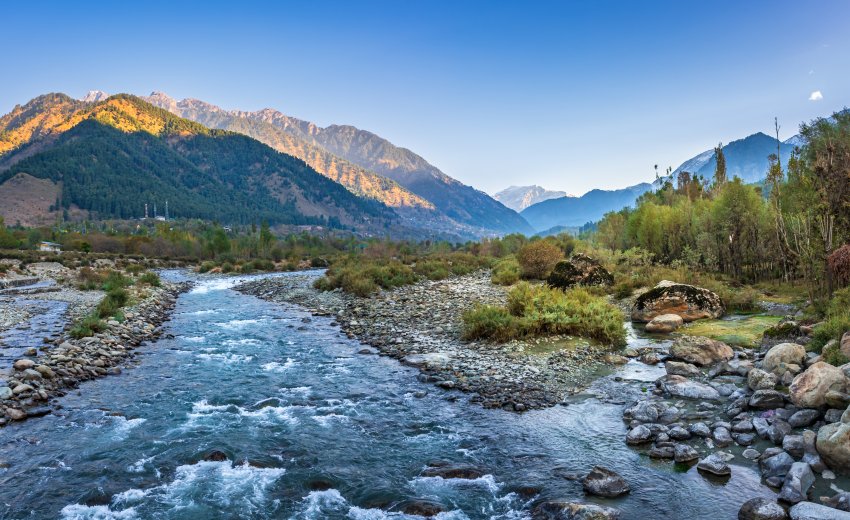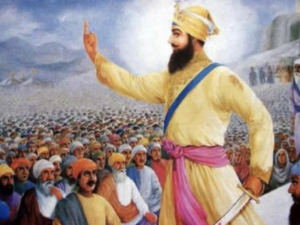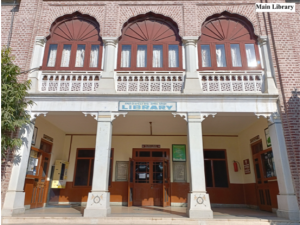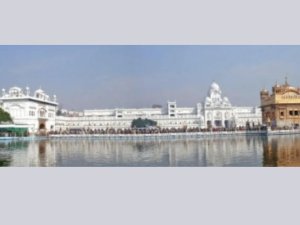Bhai Vir Singh (1872–1957), revered as the father of modern Punjabi literature, was not only a saint-poet but a visionary mystic who gave new spiritual and aesthetic dimensions to the Punjabi language. Deeply rooted in Sikh philosophy and shaped by the poetic ethos of Guru Nanak, Bhai Vir Singh’s pen became a vessel through which the divine beauty of nature—especially the sublime landscapes of Kashmir—was eternally etched into literature.
Bhai Vir Singh’s vision reminds us of Kashmir’s sacredness—not just as paradise on earth, but as a spiritual homeland of humanity’s deepest aspirations.
Gar firdaus bar rū-ye zamīn ast
Hamīn ast-o, hamīn ast-o, hamīn ast.
If there is paradise on earth,
It is here, it is here, it is here.
The poetry of Bhai Vir Singh transcends mere admiration for nature; it resonates with spiritual yearning, metaphysical longing, and mystic union. In Kashmir, he found not only a place of physical beauty but a realm where the presence of the Creator shimmered in lakes, echoed in springs, and lingered in the silence of valleys.
His celebrated collection Matak Hulare (Celestial Vibrations) captures these experiences with rare lyricism and transcendental intensity.
A poignant example is his reflection at the spring of Ichhabal:
“Sanjh hoi parchanve chhup gaye,
Kyon Ichhabal toon jaari?
Nat sarod kar rahi viwan hi,
Te turno bhi nahin haari.”
It is dusk, the shadows have faded.
Ichhabal, why do you still flow?
The lute has fallen silent,
Yet your steps do not tire.
The spring answers in a metaphor of divine love:
“Seene khich jina ne khadi,
O kar araam nahin bhende,
Nehon wale naina ki neender,
Oh din raat pae vahende.”
Those whose hearts burn with longing
Know no rest.
Eyes filled with deep love
Do not sleep—
Their tears flow, day and night.
In the poem Martand de Khandar, the poet says:
Maar paii sad Martand nu,
Pathar roye, kuliah paye:
"Pathar toṛdein? Dilan te tuṭdein —
Dil, Kaaba, Rab ne banaya.
Laaye hathora saanu?
Par das tu — tu kinūn Rab samjhaya?"Satt paii "Rabb de ghar" nu,
Oh ghar — jo har ghar vich vasda.
When the blows struck Martand,
Even the stones wept aloud:
"You’re breaking stones? Hearts are shattering —
The heart, the Kaaba, is shaped by God.
You wield the hammer on us?
But tell us — who do you count as God?"The strike fell upon the “house of God,”
That house — which dwells in every home. (Ruins of Martand)
In his other poem Nishat Bagh the poet says:
Dal de sir da taaj, kharra Nishat,
Pahaṛ di god vich.
Haan, latyaal — ṭillian utte pehredaar,
Pichhe han — agge nahin.
Darbaar Dal da vikThe crown of Dal’s head, stands Nishat,
Cradled in the arms of the mountains.
Yes, grand — guarded on hillocks,
Behind — never ahead.
This is Dal's own royal court!"(Nishat Bagh)
Such verses are not merely poetic observations—they are revelations, where water flows like eternal longing, and valleys echo with the music of separation and union. The poem Matak Hulare itself is a song of nature swaying in spiritual ecstasy:
Kavita di sunder hai
Nachae nachharri vasdi
Aapne sangeet lahre
Apne Parkash lasdi
The beauty of poetry
Dances with nature’s rhythm,
Flowing in waves of music,
Shining in its own divine light.
To Bhai Vir Singh, Kashmir was not just a place—it was a metaphor of divine presence, a living scripture in landscape. Gulmarg’s serenity and Pahalgam’s grace became sites of inner stillness and mystical absorption. His verses offer not only aesthetic joy but also ethical counsel—to revere nature as sacred and preserve it as a legacy of divine artistry.
Chattopadhyay rightly called him the “Sixth River of Punjab,” and he was hailed as the “Sikh of the Century.” His poetic Kashmir remains an immortal tribute—where celestial vibrations still echo, and every whisper of the breeze carries the fragrance of prayer.





